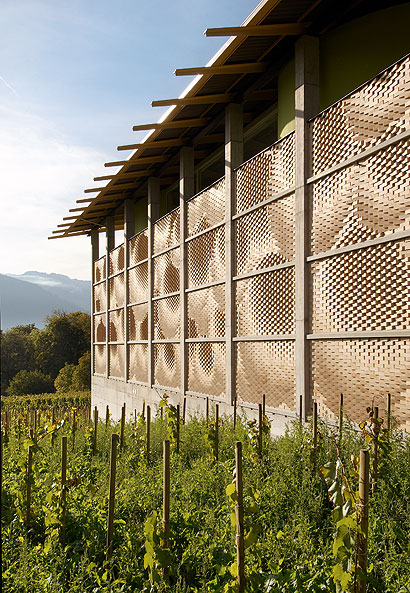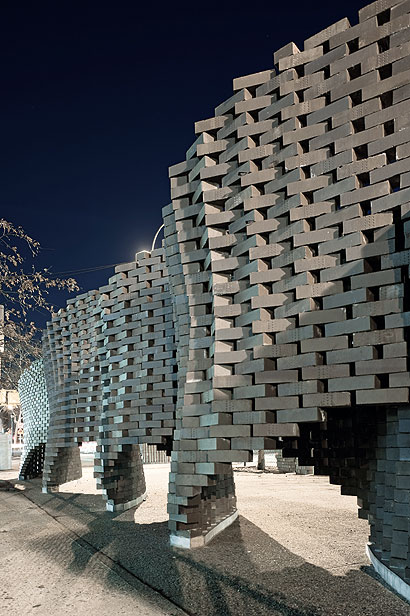|
The robot And the architect are friends. That’s the philosophy of Swiss architects Fabio Gramazio and Matthias Kohler. They have a vision: architecture using robotics to take command of all aspects of construction. Liberated from the sidelines, the profession would be freed to unleash all its creative potential – all thanks to its obedient servants, the robots. But first, architects must learn the robots’ language. This mechanised revolution is being plotted from suburban Zurich. The Hönggerberg campus of the ETH technical university is a smart collection of low-rise modern buildings a bus and a tram ride away from the historic centre of the Swiss city. It looks much as you’d expect a Swiss science park to look: well tailored, serious and expensive. Gramazio and Kohler, who have led the professorship for architecture and digital fabrication at ETH Zurich since 2005, have offices here. But the star of the story lives in a cell in the campus’ cavernous engineering bay. In this hangar-like space, under huge ceiling-mounted gantry cranes and surrounded by the curious misshapes of architectural experimentation, is KR150 L110, a machine manufactured by the KUKA robotics company of Augsburg, Germany. An orange, articulated arm with three joints roughly corresponding to its shoulder, elbow and wrist, KR150 L110 is suitable for a huge variety of industrial tasks. Indeed, it can do almost anything, depending on what tool you attach to its wrist, and what programs you write for it. This is how Gramazio and Kohler make architecture – by programming. It’s an unprecedented way to practise their profession. “Suddenly there is no plan, no geometry, no drawing produced in the first instance,” says Kohler. Instead, there’s a page of instructions, written in the machine’s command language, that tell it, for instance, to pick up a brick and place it, and then to repeat the process with variations. When this program runs, the result is a wall. The form of the wall is implicit in the instructions, literally coded into them. And the machines can produce quite extraordinary forms. KR150 L110 has a brother in showbiz – R-O-B, a “mobile fabrication unit”, which tours the world in a shipping container showing off. Gramazio and Kohler (and R-O-B) first came to widespread attention in 2008 with a long, rippling brick partition that snaked through every part of the Swiss pavilion at the Venice Architecture Biennale. Since then, the robot has been used to build the facade of a winery designed by Bearth & Deplazes Architects (Gramazio & Kohler’s colleagues at ETH) and an arched wall for New York’s Storefront for Art & Architecture (icon 079). These undulating, swooping, highly textured installations all needed precision far beyond the capabilities of human bricklayers.
A brick facade by Gramazio & Kohler But the forms the robot can enable are secondary to what Gramazio and Kohler see as the real importance of the technology they are developing. Rather than create a new aesthetic or a new style – the dream of the parametricists generally associated with today’s highest high-tech architecture – they want to transform the profession, to oversee the birth of a new breed of architect-programmer with extraordinarily expanded power. “For a long time, the architect has been pushed back from the building of things into the role of pure designer,” Gramazio says. “He has been losing all the knowledge of the actual [and] has been pushed into a marginal role. He is not taking real responsibility any more because he is not in charge of the ultimate building process.” By programming architecture, the architect is able to control construction down to the fine details – ranks of middlemen are deposed, and new fields of creativity are opened up. This has been the dream of both Gramazio and Kohler since the beginning of their careers. They’re a reserved pair, friendly but far from flamboyant; Gramazio is slim and intense, while Kohler is more avuncular. Both are digital natives – they have been programming computers since childhood, a fact that marks them out as a radically new generation of architects. They met as students using ETH’s computer lab in the mid-1990s, where they found they shared a frustration with the use that architects were making of computers. The trouble was that computers were just being used as tools, to produce drawings – they weren’t fully integrated into construction. “The two worlds, the virtual and the physical, were treated as being contradictory or opposite,” says Kohler. “Virtual architecture meant something done on the computer. This was a complete misunderstanding.” Feeling a deep sympathy between architecture and programming, the pair imagined a kind of architecture that smashed the barriers between the “virtual” and the “actual”. They founded a design studio together in 2000, and after assuming their professorships started to experiment with robotics. Robots, they felt, would allow them to achieve their aim of “computer architecture” that was 100 percent real – so that programming and architecture became indistinguishable, seamless, the same process. An idea is just information – the robot can turn it perfectly into an object. The robot is a prosthesis fusing the architect and the building. This is cyborg architecture – a philosophy the pair call “digital materiality”. The robot’s “cell” is a surprisingly tight space on one side of the ETH engineering bay. The machine itself moves with the clipped grace we associate with robotics, performing neat, discrete actions that contain within them an assortment of fluid swivels and turns. These quick-slow, deliberate movements are hypnotic. It’s beautiful to watch but, because it moves in a way that looks animal while being unlike anything we know in nature, there’s something in it that’s inescapably unnerving. Under the control of a student, the robot pivots and spears a foam block with a pronged element currently serving as its “hand”. This part of the robot, the bit that actually interacts with the environment, is called an “end-effector” – a significant part of Gramazio and Kohler’s work has been to design these tools. With the block impaled, the robot lifts it and swivels it around to a hot wire, which cuts a wedge out of the block. Nearby is a chest-high structure like an emaciated cooling tower or an inverted funnel, being built out of these custom parts.
Pike Loop, the robot-built wall for New York’s Storefront for Art and Architecture, lifts off the ground and required great precision Guided by Gramazio and Kohler and their students, the robot is learning new tricks – here, using non-orthogonal blocks. The robots’ next big job is the facade of an apartment building, now in the early stages of design. The main technical challenge is mastering load-bearing structures – arches and pillars are among the architectural oddments littering the bay. But the architects are supremely confident the obstacles can be overcome. “We believe that in the next 20 years a large part of the construction industry – large parts of it are still very primitive – will move to digital fabrication,” Gramazio says. He compares it to the timber industry, which reinvented its fortunes through automation. “We think that the same will take place in construction, which still plans like it’s 200 years ago, redrawing everything five times, making a lot of mistakes on site, delivering a very poor quality for a high price, and dramatically limiting creative or expressive potential.” Much of this sounds like the rhetoric of mass-production that excited the architects of the Bauhaus or the prefabrication zealots of the 1960s – there has been a persistent drive towards automation in modernism, one that has always promised great things but has rarely delivered them. But Gramazio and Kohler see automation as a way of getting closer to architecture, not as a way of stepping back and letting the machines do the work. They see the robot as allowing the architect to return to the tactile expertise of an earlier generation of craftsmen. “The machine is hands-on,” Gramazio insists. “If you look at an historic building they’re amazing, the richness of the detailing …that [with today’s industry] is just not possible, we couldn’t pay for it, plus we don’t have the skilled labour any more. Through industrialisation and automation … this will change.” Most people involved in digital architecture, he says, are just interested in computation – “they forget the final act of craft”. They both prefer to leave the aesthetic possibilities of digital materiality a moot point, preferring to see their job as demystifying the technology rather than imposing a style on anyone – although their own style is clearly evident in their work, a very Swiss style, all precision and dark engineering bricks. They favour bricks as the most “digital” of materials, operating like pixels or bits; an experiment with a more analogue material, polyurethane foam, yielded messy and unsatisfactory results. Considering the revolutionary potential of their work, you might expect a note of utopian zeal from the pair. If you want dazzling Wellsian predictions, delivered with glittering eyes, of future armies of architect-controlled mechanoids transforming the world, you’ve come to the wrong place. Instead they’re understated, modest, reasonable. Do they ever get excited by their work and the huge changes it could mean? “Sure, sure,” Gramazio answers in a somnolent deadpan. Perhaps sensing that this answer lacks a certain something, Kohler chimes in: “Why else would we do this? Why would we go through the pain of doing all this? This work is very much a process of discovery as opposed to a process of total control in terms of designing a fixed geometry or making a design on a napkin … it’s a moment of discovery that is embedded within working with these technologies. Designing processes and … discovering the results of these processes are learning the nature of design. So this is very exciting.” “We are convinced that deep integration of digital logics into the craft of architecture will change architecture in a dramatic way,” Gramazio adds seriously. “And what these changes will look like, it’s hard to say … there will be fantastic projects and terrible projects. But the simple fact that it’s happening is exciting for an architect because we are able to redefine many things that we assume to be given.” On the other hand, beyond utopian excitement, does their research ever worry them? Killer robot fantasies aside, previous flirtations between architecture and automation – such as prefabrication and system-building – have started with high ideals and ended with the architect being disenfranchised as contractors drive down costs and quality. “If you do research or inventing, it could always go in the wrong direction – this is part of the deal,” says Gramazio. “But technology is happening anyhow … being scared of technology is no solution.” Architects should, he says, learn from the horrible experience of using CAD. Computer-aided design was not embraced by the profession when it first appeared, so architects had little say in how it developed, and engineers took the lead. Now architects have to use CAD, and often find the experience unsatisfactory. They should not repeat the mistake with robotics. “There will be people who will misuse [the technology], but that has always been the case,” Kohler adds. “But we don’t think it’s going to be better if architects don’t engage in it.” |
Image Juventino Mateo
Words William Wiles |
|
|
||
|
R-O-B, the mobile fabrication unit, building Pike Loop |
||






















